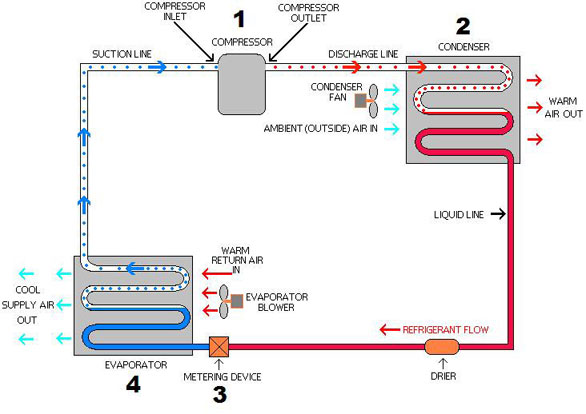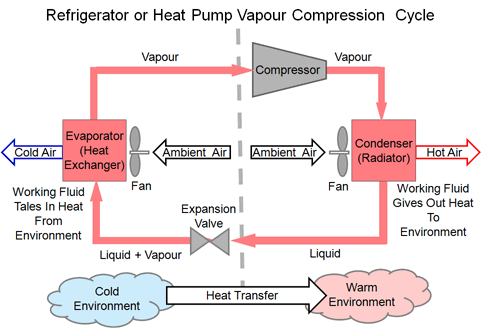Thermodynamic
heat pump cycles or refrigeration cycles are the conceptual and
mathematical models for heat pumps and refrigerators .A heat pump
is a machine or device that moves heat from one location at a lower
temperature to another location at a higher temperature using
mechanical work or a high-temperature heat source.
Thus a heat pump may be thought of a "heater" if the objective is to warm the heat sink , or a "refrigerator" if the objective is to cool the heat source .
An air conditioner requires work to cool a living space, moving heat from the cooler interior to the warmer outdoors . Similarly, a refrigerator moves heat from inside the cold icebox to the warmer room-temperature air of the kitchen .
Heat pump and refrigeration cycles can be classified as vapor compression, vapor absorption, gas cycle, or Stirling cycle types.
The thermodynamics of the cycle can be analysed on a diagram as shown in Figure 2. In this cycle, a circulating refrigerant such as Freon enters the compressor as a vapour.
The above discussion is based on the ideal vapour-compression refrigeration cycle, and does not take into account real-world effects like frictional pressure drop in the system, slight thermodynamic irreversibility during the compression of the refrigerant vapour, or non-ideal gas behaviour .
In the absorption system, the compressor is replaced by an absorber which dissolves the refrigerant in a suitable liquid, a liquid pump which raises the pressure and a generator which, on heat addition, drives off the refrigerant vapour from the high-pressure liquid.
When the working fluid is a gas that is compressed and expanded but does not change phase, the refrigeration cycle is called a gas cycle.
As there is no condensation and evaporation intended in a gas cycle, components corresponding to the condenser and evaporator in a vapor compression cycle are the hot and cold gas-to-gas heat exchangers in gas cycles.
The gas cycle is less efficient than the vapor compression cycle because the gas cycle works on the reverse Brayton cycle instead of the reverse Rankine cycle .
In the gas cycle, the refrigeration effect is equal to the product of the specific heat of the gas and the rise in temperature of the gas in the low temperature side.
The Stirling cycle heat engine can be driven in reverse, using a mechanical energy input to drive heat transfer in a reversed direction .
A heat pump may be compared with a chp unit, in that for a condensing steam plant, as it switches to produced heat, then electrical power is lost or becomes unavailable, just as the power used in a heat pump becomes unavailable.
Thus a heat pump may be thought of a "heater" if the objective is to warm the heat sink , or a "refrigerator" if the objective is to cool the heat source .
An air conditioner requires work to cool a living space, moving heat from the cooler interior to the warmer outdoors . Similarly, a refrigerator moves heat from inside the cold icebox to the warmer room-temperature air of the kitchen .
Heat pump and refrigeration cycles can be classified as vapor compression, vapor absorption, gas cycle, or Stirling cycle types.
The thermodynamics of the cycle can be analysed on a diagram as shown in Figure 2. In this cycle, a circulating refrigerant such as Freon enters the compressor as a vapour.
The above discussion is based on the ideal vapour-compression refrigeration cycle, and does not take into account real-world effects like frictional pressure drop in the system, slight thermodynamic irreversibility during the compression of the refrigerant vapour, or non-ideal gas behaviour .
In the absorption system, the compressor is replaced by an absorber which dissolves the refrigerant in a suitable liquid, a liquid pump which raises the pressure and a generator which, on heat addition, drives off the refrigerant vapour from the high-pressure liquid.
When the working fluid is a gas that is compressed and expanded but does not change phase, the refrigeration cycle is called a gas cycle.
As there is no condensation and evaporation intended in a gas cycle, components corresponding to the condenser and evaporator in a vapor compression cycle are the hot and cold gas-to-gas heat exchangers in gas cycles.
The gas cycle is less efficient than the vapor compression cycle because the gas cycle works on the reverse Brayton cycle instead of the reverse Rankine cycle .
In the gas cycle, the refrigeration effect is equal to the product of the specific heat of the gas and the rise in temperature of the gas in the low temperature side.
The Stirling cycle heat engine can be driven in reverse, using a mechanical energy input to drive heat transfer in a reversed direction .
A heat pump may be compared with a chp unit, in that for a condensing steam plant, as it switches to produced heat, then electrical power is lost or becomes unavailable, just as the power used in a heat pump becomes unavailable.



No comments:
Post a Comment